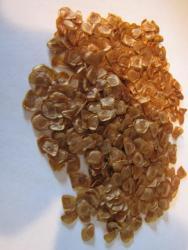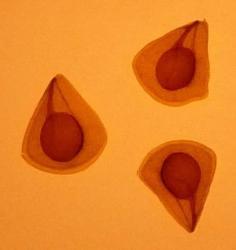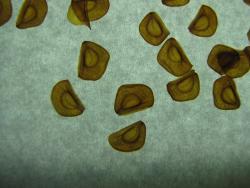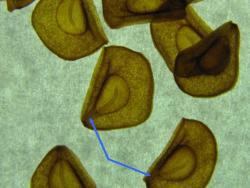So I am hijacking some info from another thread (starting with
this post) that is worthy of placing here, so it's not forgotten. Lorn shows a harvest of hybrid trumpet lily seed with extra large "flaps", the thin, papery part of the seed that helps make it airborne when the wind blows. Correspondingly, the large flaps accompany a smaller than normal actual seed, which includes the part (the endosperm) that is the food for seed germination. He hopes there will be enough nourishment to sustain growth, as there is usually a greater amount of stored food in trumpet lily seed.

I don't have a lot of experience with trumpet lilies, but if other species lilies are any indication, there shouldn't be any problem. For instance, small seeds with large flaps are normal for Lilium michiganense:

Lorn also showed some close ups of his seed, taken when candling:


These are a great teaching photos. As well as the embryos (the lines in the middle of the seeds), it also shows the black "hair lines" that puzzled me when I first began examining lily seed. At first, I would always see them on chaff seed without visible embryos. So, I wondered whether these black hair lines were actually dead embryos. I later concluded this is not the case, and your pics, Lorn, show perfect examples.

Lorn replies:
"In layman's terms, I've always thought the black line is the dead tissue of what was (for lack of a better term) the umbilical cord that nourishes the embryo sac until it's ripe. When the seed gets ripe the umbilical cord dries up and we see it as a black line. If you look closely [or zoom in the photo] you can see part of the so called umbilical cord which is STILL ALIVE near the point where the seed was attached to the core on many of these seeds. Based on that observation, I left these seeds on the paper to dry a little more."
So, I believe you mean this as the still alive part:

I don't know what to say about that. Eybrow raising, isn't it? Is it still alive or just not dead yet... Wait, that didn't come out right.

I mean - does it matter? If you let the seed dry more, what happens.... does the "still alive" part then look dead?
But I do wonder about the umbilical chord theory. Why would the umbilical cord (the black hair line) run along side the seed and
past it?





